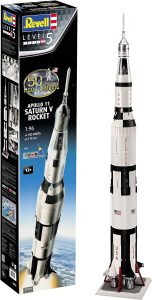Imagine soaring to new heights with your very own large model rocket, leaving a trail of excitement and awe in its wake. Welcome to the world of model rocketry, where creativity, innovation, and thrill-seeking come together in a burst of color, sound, and adrenaline. Whether you're a seasoned enthusiast or just starting out, this comprehensive guide will walk you through the art and science of building large model rockets, from design and construction to launch and recovery.
Quick Links to Useful Sections
- What Makes a Large model rocket?
- Designing Your Large Model Rocket
- Choosing a Shape
- Selecting Materials
- Configuring the Fins
- Building Your Large Model Rocket
- Constructing the Body Tube
- Installing the Recovery System
- Adding Electronics and Avionics
- Launching and Recovering Your Large Model Rocket
- Pre-Launch Checks
- Launch and Ascent
- Recovery and Post-Flight Analysis
- Resources and community Support: Your Next Steps
- Frequently Asked Questions: Large Model Rockets
What Makes a Large model rocket?
Large model rockets are more than just scaled-up versions of their smaller counterparts. They require careful planning, precision engineering, and attention to detail to ensure a safe and successful flight. But what exactly defines a large model rocket?
- Size: Large model rockets typically have a minimum diameter of 2.5 inches (6.4 cm) and can reach heights of over 1,000 feet (305 meters).
- Weight: They can weigh anywhere from a few pounds to several dozen pounds, depending on the materials and design.
- Complexity: Large model rockets often feature intricate designs, multiple stages, and sophisticated electronics.
Building a large model rocket is a significant undertaking that demands patience, skill, and a passion for innovation. But the rewards are well worth the effort – the thrill of launch, the rush of adrenaline, and the sense of pride and accomplishment.
Designing Your Large Model Rocket
Before you start building, you need a solid design concept. This is where creativity meets engineering, and the possibilities are endless.
Choosing a Shape
The shape of your rocket will determine its aerodynamics, stability, and overall performance. Popular shapes include cylindrical, conical, and elliptical.
Looking For The Best Model Rocket Kits? You'll Love These:
Selecting Materials
Your choice of materials will impact the weight, strength, and durability of your rocket. Common materials include fiberglass, carbon fiber, and wood.
Configuring the Fins
The fins of your rocket provide stability and control during flight. You can choose from a variety of fin shapes, sizes, and configurations.
A well-designed large model rocket is a work of art that requires careful consideration of form, function, and performance.
Building Your Large Model Rocket
With your design concept in hand, it's time to start building. This is where the magic happens, and your vision takes shape.
Constructing the Body Tube
The body tube is the main structure of your rocket, and its construction requires precision and attention to detail.
Installing the Recovery System
A reliable recovery system is crucial for retrieving your rocket after launch. You can choose from parachutes, streamers, or other custom solutions.
Adding Electronics and Avionics
Electronics and avionics play a critical role in the performance and safety of your rocket. You can install altimeters, GPS trackers, and other components to enhance your rocket's capabilities.
Building a large model rocket is a complex process that demands patience, skill, and attention to detail. But with the right tools and techniques, you can create a masterpiece that will leave onlookers in awe.
Launching and Recovering Your Large Model Rocket
The moment of truth has finally arrived – it's time to launch your large model rocket and experience the thrill of flight.
Pre-Launch Checks
Before launch, make sure to conduct thorough checks on your rocket's systems, weather conditions, and launch site.
Launch and Ascent
The launch sequence is a critical phase of the flight, and your rocket's performance will depend on a combination of design, construction, and launch conditions.
Recovery and Post-Flight Analysis
After launch, your rocket will return to Earth, and it's essential to recover it safely and analyze its performance to improve future flights.
Launching and recovering a large model rocket is an exhilarating experience that requires careful planning, attention to detail, and a passion for adventure.
Resources and community Support: Your Next Steps
Building and launching a large model rocket is just the beginning of your journey. Join a community of enthusiasts, attend workshops and events, and stay up-to-date with the latest trends and technologies.
- Online Forums and Communities: Connect with fellow model rocket enthusiasts, share tips and advice, and showcase your creations.
- Local Clubs and Meetups: Join local clubs and attend meetups to network with other enthusiasts, learn from experts, and participate in group launches.
- Workshops and Events: Attend workshops, seminars, and competitions to improve your skills, learn from industry experts, and stay inspired.
The world of model rocketry is vibrant and dynamic, with a wealth of resources and opportunities available to help you take your passion to new heights.
Frequently Asked Questions: Large Model Rockets
Here are some frequently asked questions about building and launching large model rockets:
1. What is the largest model rocket I can build?
The largest model rocket you can build depends on local regulations, safety considerations, and your skills and resources.
2. How high can a large model rocket fly?
The altitude of a large model rocket depends on its design, construction, and launch conditions, but it can reach heights of over 10,000 feet (3,048 meters).
3. What safety precautions should I take when launching a large model rocket?
Always follow safety guidelines, ensure a safe launch site, and wear protective gear to minimize risks.
Looking For The Best Model Rocket Kits? You'll Love These:
Useful Interruption: Dive deeper into the world of Model Rockets with our most popular sections. If there is anything you think is missing or anything you would love for us to write about, just give us a shout.
- Getting Started & Basics With Model Rockets
- Model Rocket Design, Build & Customization
- Model Rocket Propulsion & Engine Technology
- Model Rocket Launch Techniques & Recovery
- Model Rocket Advanced Rocketry & Innovations
- Model Rocket DIY and Customization
- Model Rocket Equipment Reviews & Digital Tools
- Community, Competitions & Education
- Model Rocket Troubleshooting & FAQs
- Model Rocket Bonus/Seasonal & Niche Topics
A group of model rocket enthusiasts gathered at a field for their weekly launch event. Among them was Dave, a seasoned builder known for pushing the limits of hobby rocketry. This time, he had outdone himself.
“Ladies and gentlemen,” Dave announced, dramatically pulling a cloth off his latest creation, “I present to you: The Kraken!”
The crowd gasped. This wasn’t just a model rocket, it was a monster. The thing stood 8 feet tall, had six clustered engines, and was covered in enough duct tape to qualify as a classified aerospace project.
“Dave,” muttered Steve, the cautious safety officer, “Have you, uh… done the math on this?”
“Math?” Dave scoffed. “I built it in my garage at 3 a.m. with parts from eBay. This is an art piece, Steve.”
The countdown began.
5…
4…
3…
2…
1…
The engines ignited with a BOOM, and The Kraken shot up… kind of. It immediately did a violent barrel roll, narrowly missing the spectators before skyrocketing at an angle that could only be described as “legally questionable.”
The crowd collectively ducked as The Kraken flew straight over the adjacent cornfield, where Old Man Jenkins, the grumpiest farmer in town, was minding his business.
KABOOM!
The rocket disappeared behind the barn. A moment later, a flaming piece of Estes igniter wire landed at Steve’s feet. The silence was deafening.
And then, an unmistakable sound echoed across the field.
Jenkins’ shotgun being cocked.
“DAVE!!!” Steve shouted. “RUN.”
And that was the day Dave invented the first-ever biologically powered rocket booster: pure adrenaline.
To this day, nobody knows where The Kraken landed, but legend has it, it still haunts the skies, terrifying unsuspecting drones and low-flying birds.















